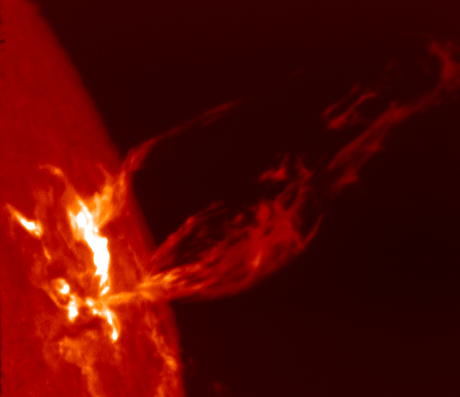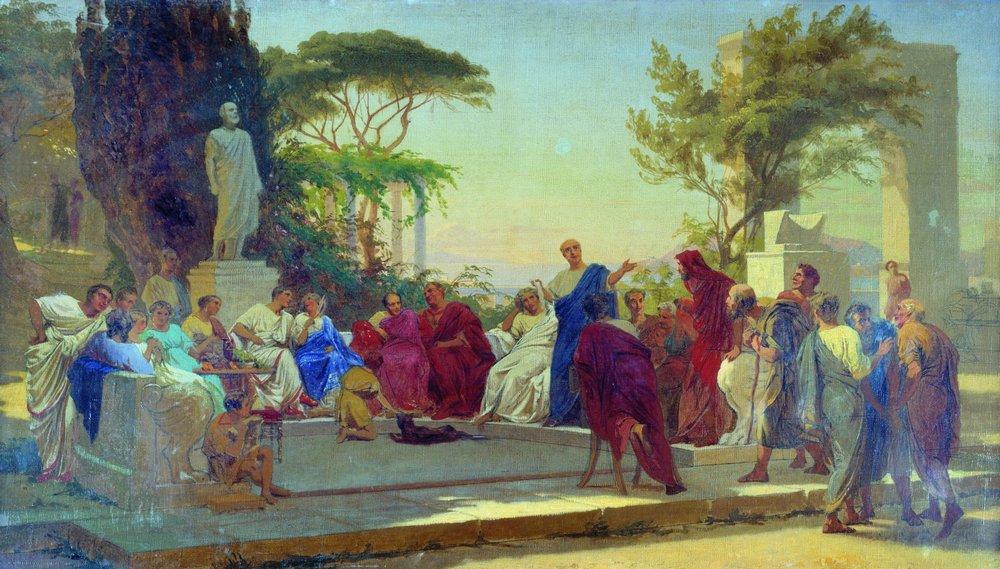|
17 Comae Berenices
17 Comae Berenices (17 Com) is a multiple star system in the northern constellation of Coma Berenices. The brighter component, 17 Com A, is a naked eye star with an apparent visual magnitude of 5.2. It has a faint companion of magnitude 6.6, 17 Com B, positioned at an angular separation of along a position angle of 251°, as of 2018. They are located at a distance of approximately 240 light years from the Sun based on parallax measurements. The double nature of this system was documented by F. G. W. Struve in 1836. The pair share a common proper motion through space and thus may be associated. Component B is itself a binary star system, although only the brighter component is visible in the spectrum. The Washington Double Star Catalogue lists the companion as component C, with a magnitude of 13.7 and a separation of . 17 Com has been recognized as members of the Coma Star Cluster, but this is disputed. The star 17 Com A was classified as chemically peculiar by ... [...More Info...] [...Related Items...] OR: [Wikipedia] [Google] [Baidu] |
Coma Berenices
Coma Berenices is an ancient asterism in the northern sky, which has been defined as one of the 88 modern constellations. It is in the direction of the fourth galactic quadrant, between Leo and Boötes, and it is visible in both hemispheres. Its name means "Berenice's Hair" in Latin and refers to Queen Berenice II of Egypt, who sacrificed her long hair as a votive offering. It was introduced to Western astronomy during the third century BC by Conon of Samos and was further corroborated as a constellation by Gerardus Mercator and Tycho Brahe. It is the only modern constellation named for a historic person. The constellation's major stars are Alpha, Beta, and Gamma Comae Berenices. They form a half square, along the diagonal of which run Berenice's imaginary tresses, formed by the Coma Star Cluster. The constellation's brightest star is Beta Comae Berenices, a 4.2- magnitude main sequence star similar to the Sun. Coma Berenices contains the North Galactic Pole and on ... [...More Info...] [...Related Items...] OR: [Wikipedia] [Google] [Baidu] |
Annie Jump Cannon
Annie Jump Cannon (; December 11, 1863 – April 13, 1941) was an American astronomer whose cataloging work was instrumental in the development of contemporary stellar classification. With Edward C. Pickering, she is credited with the creation of the Harvard Classification Scheme, which was the first serious attempt to organize and classify stars based on their temperatures and spectral types. She developed the mnemonic "Oh! Be A Fine Girl — Kiss Me!" used by students to memorize the spectral classification of stars. She was nearly deaf throughout her career after 1893, as a result of scarlet fever. She was a suffragist and a member of the National Women's Party. Personal life Cannon was born on December 11, 1863, in Dover, Delaware. She was the eldest of three daughters born to Wilson Cannon, a Delaware shipbuilder and state senator, and his second wife, Mary Jump. Cannon's mother was the first person to teach her the constellations and she encouraged her to follow her own in ... [...More Info...] [...Related Items...] OR: [Wikipedia] [Google] [Baidu] |
Ap Star
Ap and Bp stars are chemically peculiar stars (hence the "p") of spectral types A and B which show overabundances of some metals, such as strontium, chromium and europium. In addition, larger overabundances are often seen in praseodymium and neodymium. These stars have a much slower rotation than normal for A and B-type stars, although some exhibit rotation velocities up to about 100 kilometers per second. Magnetic fields Ap and Bp stars have stronger magnetic fields than classical A- or B-type stars; in the case of HD 215441, reaching 33.5 k G (3.35 T). Typically the magnetic field of these stars lies in the range of a few kG to tens of kG. In most cases a field which is modelled as a simple dipole is a good approximation and provides an explanation as to why there is an apparent periodic variation in the magnetic field, as if such a field is not aligned with the rotation axis—the field strength will change as the star rotates. In support of this theory it has been no ... [...More Info...] [...Related Items...] OR: [Wikipedia] [Google] [Baidu] |
George W
George Walker Bush (born July 6, 1946) is an American politician who served as the 43rd president of the United States from 2001 to 2009. A member of the Republican Party, Bush family, and son of the 41st president George H. W. Bush, he previously served as the 46th governor of Texas from 1995 to 2000. While in his twenties, Bush flew warplanes in the Texas Air National Guard. After graduating from Harvard Business School in 1975, he worked in the oil industry. In 1978, Bush unsuccessfully ran for the House of Representatives. He later co-owned the Texas Rangers of Major League Baseball before he was elected governor of Texas in 1994. As governor, Bush successfully sponsored legislation for tort reform, increased education funding, set higher standards for schools, and reformed the criminal justice system. He also helped make Texas the leading producer of wind powered electricity in the nation. In the 2000 presidential election, Bush defeated Democratic incumb ... [...More Info...] [...Related Items...] OR: [Wikipedia] [Google] [Baidu] |
Blue Straggler
A blue straggler is a main-sequence star in an open or globular cluster that is more luminous and bluer than stars at the main sequence turnoff point for the cluster. Blue stragglers were first discovered by Allan Sandage in 1953 while performing photometry of the stars in the globular cluster M3. Standard theories of stellar evolution hold that the position of a star on the Hertzsprung–Russell diagram should be determined almost entirely by the initial mass of the star and its age. In a cluster, stars all formed at approximately the same time, and thus in an H–R diagram for a cluster, all stars should lie along a clearly defined curve set by the age of the cluster, with the positions of individual stars on that curve determined solely by their initial mass. With masses two to three times that of the rest of the main-sequence cluster stars, blue stragglers seem to be exceptions to this rule. The resolution of this problem is likely related to interactions between two or more ... [...More Info...] [...Related Items...] OR: [Wikipedia] [Google] [Baidu] |
Color Index
In astronomy, the color index is a simple numerical expression that determines the color of an object, which in the case of a star gives its temperature. The lower the color index, the more blue (or hotter) the object is. Conversely, the larger the color index, the more red (or cooler) the object is. This is a consequence of the logarithmic magnitude scale, in which brighter objects have smaller (more negative) magnitudes than dimmer ones. For comparison, the whitish Sun has a B−V index of , whereas the bluish Rigel has a B−V of −0.03 (its B magnitude is 0.09 and its V magnitude is 0.12, B−V = −0.03). Traditionally, the color index uses Vega as a zero point. To measure the index, one observes the magnitude of an object successively through two different filters, such as U and B, or B and V, where U is sensitive to ultraviolet rays, B is sensitive to blue light, and V is sensitive to visible (green-yellow) light (see also: UBV system). The set of passbands or ... [...More Info...] [...Related Items...] OR: [Wikipedia] [Google] [Baidu] |
Ed Van Den Heuvel
Edward Peter Jacobus (Ed) van den Heuvel (born 2 November 1940) is a Dutch astronomer and emeritus professor at the Astronomical Institute Anton Pannekoek of the University of Amsterdam. Van den Heuvel is well known for his work on the formation and evolution of compact astrophysical objects such as neutron stars, black holes, and white dwarfs in binary systems, and for his investigation of gamma ray bursts. Van den Heuvel studied mathematics, physics and astronomy at the Utrecht University. There, he obtained his PhD degree in 1968 for his research on the rotation of stars. During his career he held positions at (amongst others) the University of California, Utrecht University, Institute for Advanced Study, and the Vrije Universiteit Brussel. For his work Van den Heuvel has been awarded with an Honorary Doctorate from the Katholieke Universiteit Leuven, the Spinozapremie (1995), the European Union Descartes Prize (2002) and the Viktor Ambartsumian International Science ... [...More Info...] [...Related Items...] OR: [Wikipedia] [Google] [Baidu] |
Stellar Magnetic Field
A stellar magnetic field is a magnetic field generated by the motion of conductive plasma inside a star. This motion is created through convection, which is a form of energy transport involving the physical movement of material. A localized magnetic field exerts a force on the plasma, effectively increasing the pressure without a comparable gain in density. As a result, the magnetized region rises relative to the remainder of the plasma, until it reaches the star's photosphere. This creates starspots on the surface, and the related phenomenon of coronal loops. Measurement The magnetic field of a star can be measured by means of the Zeeman effect. Normally the atoms in a star's atmosphere will absorb certain frequencies of energy in the electromagnetic spectrum, producing characteristic dark absorption lines in the spectrum. When the atoms are within a magnetic field, however, these lines become split into multiple, closely spaced lines. The energy also becomes polarized with ... [...More Info...] [...Related Items...] OR: [Wikipedia] [Google] [Baidu] |
Zeeman Effect
The Zeeman effect (; ) is the effect of splitting of a spectral line into several components in the presence of a static magnetic field. It is named after the Dutch physicist Pieter Zeeman, who discovered it in 1896 and received a Nobel prize for this discovery. It is analogous to the Stark effect, the splitting of a spectral line into several components in the presence of an electric field. Also similar to the Stark effect, transitions between different components have, in general, different intensities, with some being entirely forbidden (in the dipole approximation), as governed by the selection rules. Since the distance between the Zeeman sub-levels is a function of magnetic field strength, this effect can be used to measure magnetic field strength, e.g. that of the Sun and other stars or in laboratory plasmas. The Zeeman effect is very important in applications such as nuclear magnetic resonance spectroscopy, electron spin resonance spectroscopy, magnetic resonan ... [...More Info...] [...Related Items...] OR: [Wikipedia] [Google] [Baidu] |
Thomas Cowling
Thomas George Cowling FRS (17 June 1906 – 16 June 1990) was an English astronomer. Early life and education Cowling was born in Hackney, London, the second of four sons of George Cowling and Edith Eliza Cowling (nee Nicholls). He was educated at Sir George Monoux Grammar School in Walthamstow and read mathematics at Brasenose College, Oxford from 1924 to 1930. From 1928 to 1930 he worked under Edward Arthur Milne. In 1929, Milne had no problems left to ask his student to work on and appealed to Sydney Chapman, who proposed that they work on an article on which he was working that dealt with the Sun's magnetic field. Cowling found an error in the paper that invalidated Chapman's results. After Cowling's doctorate, Chapman proposed that they work together. Academic career In 1933 Cowling wrote an article, ''The magnetic field of sunspots''. Joseph Larmor had worked in this area, arguing that sunspots regenerate themselves through a dynamo effect. Cowling showed that Larm ... [...More Info...] [...Related Items...] OR: [Wikipedia] [Google] [Baidu] |
Horace W
Quintus Horatius Flaccus (; 8 December 65 – 27 November 8 BC), known in the English-speaking world as Horace (), was the leading Roman lyric poet during the time of Augustus (also known as Octavian). The rhetorician Quintilian regarded his ''Odes'' as just about the only Latin lyrics worth reading: "He can be lofty sometimes, yet he is also full of charm and grace, versatile in his figures, and felicitously daring in his choice of words."Quintilian 10.1.96. The only other lyrical poet Quintilian thought comparable with Horace was the now obscure poet/metrical theorist, Caesius Bassus (R. Tarrant, ''Ancient Receptions of Horace'', 280) Horace also crafted elegant hexameter verses ('' Satires'' and ''Epistles'') and caustic iambic poetry ('' Epodes''). The hexameters are amusing yet serious works, friendly in tone, leading the ancient satirist Persius to comment: "as his friend laughs, Horace slyly puts his finger on his every fault; once let in, he plays about the heartstrings ... [...More Info...] [...Related Items...] OR: [Wikipedia] [Google] [Baidu] |






